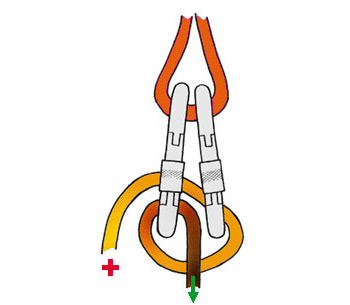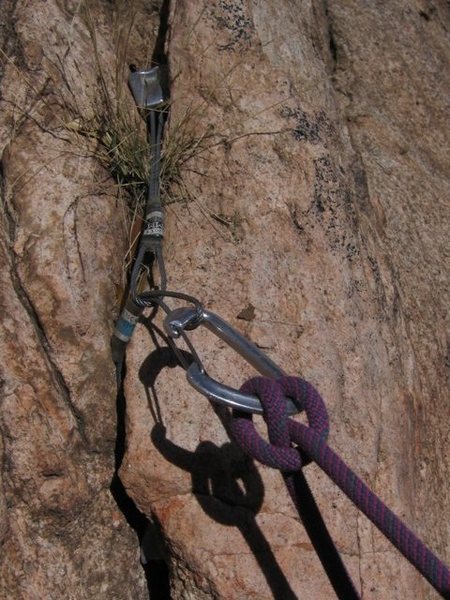Equalizing 2 pieces on lead
|
|
wivanoff wrote: We know that the Sliding X doesn't do what we thought... with clutch effect and all.I thought I remember reading from Long's Climbing Anchors book that the clutch effect was sort of random? That the (vast?) majority of the time it didn't happen, but then, here and there, for no apparent reason, it does. Am I getting that right? |
|
|
Optimistic wrote: I thought I remember reading from Long's Climbing Anchors book that the clutch effect was sort of random? That the (vast?) majority of the time it didn't happen, but then, here and there, for no apparent reason, it does. Am I getting that right?Dunno. I understood "clutch effect" was just part of the problem. I don't have Long's book. I was working off of things like this (hopefully not too far out of context): "The problems is that the tests don´t seem to have been as extensive as they could have been and things were missed. Others including myself have subsequently gone further and the two main conclusions are:- Sliding systems are much worse at sharing the force than was assumed (to the extent that some three-point systems give no force whatsoever on one piece). Extension is far more of a problem than was recognized and in the wrong situation will cause equipment failure. Adding extension limiting knots is effectively worthless since either you tie them so close that the anchor cannot equalize or so far apart so that the extension becomes a problem. " - Jim Titt 11/21/13 "We did a lot of testing with Sterling and found that binding was a bigger factor than first suspected, especially with sliding X, where a sling is basically hitched around the biner, less so on somethng like a quad, where anchor point biners are clipped though a comparatively wide loop. " - John Long 9/23/14 |
|
|
rgold wrote:I buy it in theory, but I don't think there is any practical consequence, because (1) there is no reliable equalizing mechanism and (2) the very nature of marginal pieces means we really don't have a good handle on how good they are, and if they differ greatly in holding power, then equalization could be a worse alternative.I'm supporting the use of the x in this topic. Wrt to #2, yes if the placements are marginal, then any method really wouldn't be any more or less ideal over the other. However, the overall purpose is load distribution provided solid placements. If I place two or three points that are solid, not marginal, but they can't handle the entire loading independently, then load distribution should be a valid consideration. I argue that we do indeed have a good idea about the holding power for each placement if we use solid placements, the manufacturer's rating. (I also offer that redundancy is inherently complete bullshit for this type of use -- for anyone jumping on that bandwagon) Going back to #1, agreed, there isn't any reliable (perfect) equalization in rigging. But, I'm not looking for equalization, I'm looking to maintain enough load distribution and be able to rig it in a timely fashion, an x is a quick way to achieve that. Sure, it's not perfect, but it works well enough to get the job done and not fail an anchor. Based on the some of these research reports over the years, I can agree to the clutch, so I'd like to see a limit to my direction of intended travel. Most times, I use an x for one direction of loading, usually straight down from the master point. And also, look to keep legs relatively the same length and in a good angle if I can. |
|
|
I've placed nuts that would probably rotate out as I climbed above them, that is, without an opposing nut providing the tension to hold it in place. |
|
|
Craig Childre wrote:I've placed nuts that would probably rotate out as I climbed above them, that is, without an opposing nut providing the tension to hold it in place. Toward the OP's question, I'd go sliding X. Like others here, I have trouble imagining a scenario that it would apply.Just to tie these two ideas together, a sliding X will NOT provide the opposition to keep a wonky nut in place. |
|
|
wivanoff wrote: "We did a lot of testing with Sterling and found that binding was a bigger factor than first suspected, especially with sliding X, where a sling is basically hitched around the biner, less so on somethng like a quad, where anchor point biners are clipped though a comparatively wide loop. " - John Long 9/23/14This seems to go directly to my point, thanks. Interesting. The upshot thereby being: tie a fixed knot with the pieces equalized in the expected direction of pull, yes? Probably challenging to do so in the running protection case the OP is asking about, hence rgold's advice to just use two slings, and to not try to make a silk purse out of a sow's ear. |
|
|
rgold wrote: In that situation half ropes are a substantial advantage, because you can clip a questionable overhead piece and not pay a big slack penalty if it blows. In any case, it is a lot more important to work to keep potential falls short than to equalize.One of the biggest advantages of half ropes for me, is that I can place marginal gear with the idea i'm not going to impact my entire system, just one strand and my fall is going to be shorter if the piece below the marginal piece is good. I'm not saying I intentionally place bad gear with doubles, I'm saying I sometimes DON'T dig myself a bigger mental hole when placing marginal gear. That marginal piece above my head might not hold a 20ft whipper, but it will mentally put me on top rope through the next sequence, and I still have the (hopefully) good gear below me. With a single, if the piece is really low kN in quality and I don't trust it, I then wonder what the shockload impacts on the system will be. This now creates more anxiety which is often the difference in success or failure if you aren't truly climbing at your phsyical limits. Basically, the answer to the OPs original question. Double/Half ropes and don't equalize unless absolutely necessary. |
|
|
Gunkiemike wrote: Just to tie these two ideas together, a sliding X will NOT provide the opposition to keep a wonky nut in place.I was thinking the same thing. Either clove them tight, or I've seen people just triangle of death them. Which would seem to work, in some cases though I've never done it like this myself. |
|
|
Craig Childre wrote:I've placed nuts that would probably rotate out as I climbed above them, that is, without an opposing nut providing the tension to hold it in place.As Mike said, a sliding X is of no use at all in this situation. Most other methods (eg clove-hitching) are hard to do one-handed and often can't be made tight enough to be effective. I've taken to using an "alpine clutch" (aka "garda hitch") when I have to down-tension a nut one-handed. You put the two carabiners on the top piece, then bring the (thin dyneema) sling from the bottom piece up (from the "+" position in the diagram below), wind it around in the alpine clutch configuration, as in give it a good tug, and you've got a down-tensioned set-up that is going to be about as tight as it is possible to get, one-handed and very fast. (Note: the strand that, in the picture, curves under both biners has to be pushed back up on their spines in order for the the "knot" to engage and hold tension.) |
|
|
theres realistically 2 scenarios |
|
|
Another option if it eases your mind to have two pieces "equalized" with out "shock loading" on lead with only using one hand is the following method: 1. Clip the sling to the lower piece. 2. Using the one handed clove hitch method, clove hitch the lower piece and pull tight. 3. Clip the sling in to the upper piece. 4. Pull the sling down and tight. 5. Girth hitch a carabiner on the bottom the the sling. |
|
|
That’s a cool solution. |
|
|
Dan Greenwald wrote: Well that's a nifty solution. Doesn't do much good though if you don't get it setup in the direction of fall exactly. That's the tricky part too is often a fall isn't going to load a piece exactly in one direction but more over the course of an arc. I assume the peak force will be at the bottom of that arc though. |
|
|
It would be more omnidirectional if you eliminated the bottom girth hitch wouldn’t it? |
|
|
Mark Hudon wrote: That’s the first thing I thought when I looked at it. It’s a slick set up, but I think I’d do it without the bottom girth hitch. |
|
|
One handed placement...bomber... |
|
|
Dan Greenwald wrote: I’ve done similar on small wires, but skip step 2. Why the clove? Just Clip-clip-girth (in the fall line). Any worry of a piece blowing and pulling thru the girth is needless worry, plus this two strand girth is about twice as strong as the single strand girth.
Be fun to run some statistical simulations or analysis to prove out the theory. What’s better the majority of the time — better equalization at risk of shock vs less equalization with no shock risk. |
|
|
Dan Greenwald wrote: This prevents extension in case either piece fails, but doesn't get anywhere near equalizing, If the top carabiner was frictionless, the bottom piece wouldn't get any load unless or until the top piece failed. Friction of the sling over the top carabiner means slightly less than equal load in the strand to the lower piece, and that small differential is all the lower piece takes while the anchor is intact. So all things considered, clipping a sling to both pieces and girth-hitching a carabiner at the bottom point is a better solution. |
|
|
Mark Hudon wrote: If you eliminate the bottom girth hitch, you get anchor extension if the top piece fails, and then there's really no point in the set-up. There isn't much point in any case, as a single sling clipped to both pieces with a carabiner girth-hitched at the bottom is better in every way I can think of. More versatile, eg when pieces are not vertically aligned, much better load distribution, less faffing in set-up, stronger. The only downside vs. the girth-and-clove rigging is that a longer sling might be needed. |
|
|
rgold, I disagree with your statement that it "doesn't get anywhere near equalizing." Just like anytime you are equalizing two or more pieces, you are never going to exact equalization; However some load sharing does occur. The same is true using a "cordelette" or a "quad" at an anchor. I have been using this for decades and I can tell you from the field that this system shares the load. If the bottom piece doesn't have the clove hitch and the top piece fails, then the bottom piece will be "shock loaded". In that case, you would be better off just using two separate slings for each piece. |

 Continue with onX Maps
Continue with onX Maps Continue with Facebook
Continue with Facebook
























